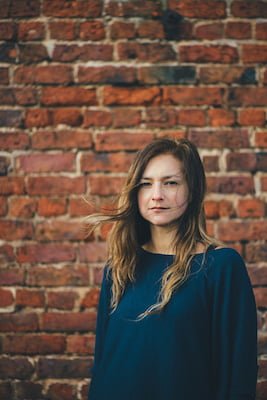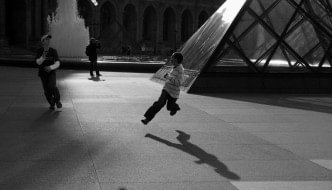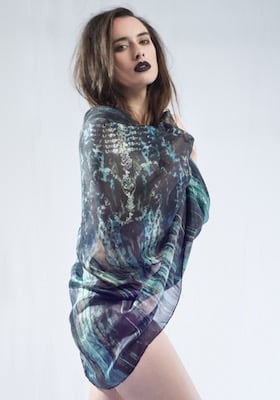Artist in the Spotlight: Oliver Neilson
December 31, 2014
There are many hidden creative gems working amongst the Leeds Art Scene. ‘Artist in the Spotlight’ is TSOTA’s attempt to shine a light on some of them. You may or may not have come across them directly, but here at TSOTA we hope to gather them together and give you their lives in few words. You can then decide if you want to know more…
This week’s Artist in the Spotlight is: Oliver Neilson
Location: Leeds
In a nutshell: “I love to collage up the world, putting this with that, putting mark with shape, with colour, with words. I can’t understand cold conceptual stuff. Where’s the fun, where’s the pleasure in the work? ‘Elegant chaos’ is what I’m going for. I have a ‘make a mess then bring something good out of that mess ‘ style.”
THEN…
TSOTA: You use reclaimed objects in your creations, from suitcases to televisions. Why did you decide to start doing this and what is it that appeals to you about using found objects?
ON: Well, the work is already done for you, you curate then create, if you open yourself up to working with found and discarded things. I did that when I was about 16 and I’ve used found objects ever since GCSE art when I built a junk man out of metal from a demolished school. The discovery of that pile of junk must’ve been a light bulb moment: everything is usable, or at least up for consideration. From then on I’ve always used found pieces as a jumping off point rather than starting from scratch on a blank canvas.
I use a lot of new wood as I live near a joinery place that leaves offcuts outside at night for the public. So these are as blank and new as I get but they’re often all shapes and sizes, which is cool, and also robust enough to create layers of expression, to sand down and scratch so they look worn, whereas the thin membrane of a canvas wouldn’t take that wear and tear. There’s Abstract Expressionism and then there’s a naturally worn and marked wall or a wall of paint patches or graffiti scratches. I’m trying to recreate the latter and I’m operating on the realms of the former.
Then there are always pieces that I find where this work has been done for you by a non-artist and has been discarded as ugly. I live these pieces. I’d love to work with building site offcuts, as I love the aesthetic. I love industrial, accidental, asymmetric, worn down things that I can ‘select’ and then ‘intervene’ on.
Compositions are syntheses of elements which have been collected from different places, from different eras but that are aiming for visual ‘harmony’ when put together, however incongruous they are initially. I say ‘harmony’ but I like abrupt juxtapositions that are Dadaist. Someone said the best fine artists are designers and the best designers are fine artists, and that’s true – I’m ultimately guided by my eye, rather than concepts. The object has two lives, one before and one after the artist’s ‘intervention’. Firstly what preceded that meeting – an object’s life in a family for instance – and then what proceeds it- what the artist does with it.

© Oliver Neilson
TSOTA: What are some examples of the ‘found and forgotten places’ you’ve worked with?
ON: I’ve kept a visual database on my phone of places I’d love to work on- certain backstreets with great marks on the walls, or little alcoves, or bricked-in windows forming natural frames. As yet I’ve only ‘hit’ one spot, I spent two weeks doing a few pieces there last month. The factory was abandoned and in a pretty rural area, walkable from my house and already graffitied, so all this stuff combined to make it a perfect spot to practice, I had the solitude to work.
It was spooky when I turned up one day and someone had sprayed their tag straight across a nearly finished piece, because I hadn’t seen anyone for two weeks. I thought, ok, disrespect yeah, but it’s a dialogue now, it’s an intervention, as my own work is an intervention. It forced to complete the piece in a different way so it was a positive bit of interference. I haven’t been back in at least a month so it’d be interesting to see what’s happened to it. So if I revisit the factory and the pieces have been ‘disrespected’ that’ll probably lure me back in, out of indignation, but in that way the pieces mutate and the beat goes on…
TSOTA: What sort of art have you supplied to TV dramas?
ON: I’ve had pieces on Emmerdale from time to time, and recently I supplied about 20 pieces of art to a drama where there was an artist character. It was nice to be primetime BBC1, I hope I get asked back for a 2nd series. With TV its best to keep art abstract, as a figure in the background, who isn’t an actor, is distracting to the audience.
TSOTA: You were born in Leeds and lived in Scotland for several years when you had graduated from the Glasgow School of Art. What made you move back?
I moved back to Leeds to work in the props department on a great kids TV show actually called My Parents are Aliens. I was a lot more connected to the interconnected music-art scene in Glasgow and I’ve never really made any waves in the Leeds one and never really embedded myself, I’m a lone operator.
NOW…
TSOTA: What would you say are the main themes in your work?
ON: It’s themes? I don’t know if I can retrospectively apply this to past work but one thing guiding me right now is: once you realise the world is always stranger than you realise, that’s so liberating. Once you research and then believe in strange phenomena and conspiracy culture, for example, it’s liberation as an artist – anything goes. If you ‘illustrate’ this stuff you’ve got a job for life.
TSOTA: The majority of your pieces seem to feature male human figures, why is this?
ON: Yes, it is usually a male who’s thin with little or no hair. He is ‘facing the camera’, bewildered in a wilderness and alone in a psychic landscape of raging, invisible forces. Man in a landscape is always a theme- man in a landscape beset by emotions and unseen forces.
The human is carrying around a world in their head. But we only see the face, the body.
I want silhouettes to contain storms. The emotional can be represented visually- I want to represent the storm outside and the storm within. Layers built into the flesh of the subjects can be scratches, texts, textures. I gather in these men from flea market photo albums or old National Geographics, selecting them because they are standing alone in a landscape with the right look on their faces. I scalpel them out of one world and put them into another, created one.
TSOTA: From where do you draw inspiration for new works?
ON: Currently, I am doing a lot of calligraphic forms- which came out of studying symbols, hieroglyphs, alphabets, graffiti, runes, digits, and sigils. So I sort of practiced these until there was ‘flow’ to them and they were made in single sweeps and could be seen as structures, energy, routes or whatever. They have gone from symbols signifying things (such as the alphabet and numbers) to these energy networks, making the invisible visible. I’m really into the metaphysical and paranormal.
TSOTA: What do you do for fun?
ON: As any artist will tell you the lack of boundary between work and pleasure is a blessing and a curse. You can make work whilst having fun all night on the plus side but you can drag junk into the house and get on people’s nerves with this lack of boundary.
Artists are so lucky as it ‘all feeds in ‘ – everything is usable and everything is inspiration. Eventually all you have to do is wait for it to ‘compost’ in your subconscious and the art becomes the fruits and shoots. But my main enemy and greatest friend is this art/life thing. I currently have about 4 storage units of junk to work on so that work/ life balance needs to happen, like, yesterday.
WHAT’S NEXT?

© Oliver Neilson
TSOTA: You’ve created some art on T-shirts. Would you ever consider producing these in quantity and making arty graphic print Tees?
ON: I love the T-shirts and would love to do more ‘wearable artworks’. The few I did years ago were one-offs. But I plan to ‘production line ‘ them, as I have a few techniques to combine, whilst still making them each unique.
TSOTA: What’s your main goal for the next few years?
ON: A major inspiration and life-changer is following some of my favourite artists on Instagram and getting their daily feeds of what they’re up to. You see them at work and play and it’s important to keep in mind that that’s what you want yourself, and it’s not so impossible. ‘Always keep a diamond in your mind’, as Tom Waits sang, and I take that to mean ‘always keep that carrot in front of you’.
So plans for the future? Be Doze Green basically. He’s someone who combines out-there esoteric subject matter with a really cool aesthetic. I’m a massive fan and he leads a great life- it’s all working for him. And that’s all I’m after: to make the art/ money struggle into a harmonious feedback loop and always make the work better. The most exciting thing for me would be demand, a demand there that I had to supply. That would be heaven.
I’ve just moved into a new studio. So it’s given me the chance to see my stuff in a large room, finished colourful pieces juxtaposed with old weathered wood. It’s given me a chance to imagine the colours and symbols and patterns jumping from the latter onto the former, and that’s what excites me – juxtaposition of beauty and decay, turning the forgotten into the desired: ‘How can this bit of wood that someone would burn on a bonfire end up, through my work, on someone else’s living room wall? What can I, as the intermediary do to it?’
TSOTA: Have you any specific ideas for new projects or ventures?
ON: One side that isn’t represented on my Instagram is photography as it is usually only shown when it makes it onto a finished bit of artwork but its on-going and for me very exciting as you get to create art in real time and real space – the elements are ‘live’ and not boxes of flat dead images on paper etc. I’m wondering what to do with it though beyond turning it into artwork… I’ve done experiments with my filmmaker friend Harry who does his Architects of Harmonic Rooms interview and music video thing and I’d like to work on films with him more. I’ve got another friend who makes his own instruments out of wood and metal so I’ve proposed we work together on making instruments. I was also talking to Ann Rutherford of east street arts the other day about moving into some of her derelict spaces and seeing if I can’t do some ‘interventions’.
Nothing is solid and to be honest I’m hopeless at plans and projects. I just like to hunker down and do things for myself then try and flog them- not a good life plan I know. But I’m up for whatever anyone would like to propose. I’d love to do public murals again for instance.
Visit www.oliverneilson.co.uk or i.instagram.com/oliverneilsonart for more of Oliver’s work.
Helena Roddis
Filed under: Art & Photography
Tagged with: artist in the spotlight



Comments